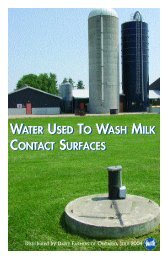Canadian Quality Milk On-Farm Food Safety Program - Centre ...
Canadian Quality Milk On-Farm Food Safety Program - Centre ...
Canadian Quality Milk On-Farm Food Safety Program - Centre ...
Create successful ePaper yourself
Turn your PDF publications into a flip-book with our unique Google optimized e-Paper software.
<strong>Canadian</strong> <strong>Quality</strong> <strong>Milk</strong><br />
Introduction<br />
Methods of milk storage have changed dramatically over the history of the dairy<br />
industry. Modern technology has enabled producers to store milk temporarily on their<br />
farms before shipping it to the processing plants. However, to be effective, the system<br />
must work and milk must be cooled quickly and stored at a temperature greater than<br />
0°C and less than or equal to 4°C to reduce bacterial growth. Monitoring the bulk tank<br />
temperature can ensure that milk is stored safely and that the cooling equipment is<br />
functioning properly.<br />
6.1 COOLING AND STORAGE OF MILK<br />
Under the HACCP-like system, cooling is one of the CCPs in milk production<br />
(CCP2). Bacteria multiply rapidly when milk is stored over 4°C (40°F) or cooled too<br />
slowly. Excessive bacteria counts and the presence of disease organisms in milk are<br />
risks to human health. A producer can control the multiplication of bacteria effectively if<br />
milk is cooled and stored properly.<br />
Critical Control Point: Cooling and storing milk<br />
Hazard: Biological: pathogenic bacteria<br />
Critical Limit: Bulk tank temperature.<br />
The 1 st milking must be cooled to 10°C or less within one hour<br />
and to a temperature greater than 0°C and less than or equal to<br />
4°C within two hours after milking and maintained at that<br />
temperature. When subsequent milkings enter the tank, blend<br />
temperature shall not rise above 10°C for longer than 15<br />
consecutive minutes and milk shall be cooled to a temperature<br />
greater than 0°C and less than or equal to 4°C within one hour<br />
after milking and maintained at that temperature.<br />
<strong>Milk</strong> cooling systems<br />
include a cooling tank that<br />
absorbs heat from the milk.<br />
The heat is transported by<br />
a refrigerant to a<br />
refrigeration unit, where it<br />
is dissipated.<br />
Some systems also have<br />
plate coolers which work to<br />
reduce the temperature of<br />
the milk before the milk<br />
reaches the refrigeration<br />
units. Plate coolers help<br />
cool milk faster.<br />
Control Measures: Check the temperature of the milk after each milking. Producers<br />
must have an accurate, operating bulk tank thermometer or recording thermometer.<br />
Producers must be able to demonstrate how they know that thermometers are accurate<br />
and operating (e.g. annually calibrate thermometers).<br />
Thermometer Calibration: thermometers can be simply calibrated by filling a glass with<br />
ice and then filling it up with cold water. Immerse the thermometer in the ice water and<br />
reposition it to read 0°C.<br />
Proper cooling is critical for the maintenance of milk safety. Recommended cooling<br />
guidelines (National Dairy Code – section 15) can be seen in Table 12.<br />
6—2<br />
June 2010
















